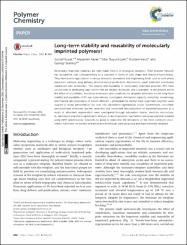| dc.contributor.author | Kupai, Jozsef | |
| dc.contributor.author | Razali, Mayamin | |
| dc.contributor.author | Büyüktiryaki, Sibel | |
| dc.contributor.author | Keçili, Rüstem | |
| dc.contributor.author | Szekely, Gyorgy | |
| dc.date.accessioned | 2019-10-23T17:56:20Z | |
| dc.date.available | 2019-10-23T17:56:20Z | |
| dc.date.issued | 2017 | |
| dc.identifier.issn | 1759-9954 | |
| dc.identifier.issn | 1759-9962 | |
| dc.identifier.uri | https://dx.doi.org/10.1039/c6py01853j | |
| dc.identifier.uri | https://hdl.handle.net/11421/22923 | |
| dc.description | WOS: 000394960900004 | en_US |
| dc.description | PubMed ID: 28496524 | en_US |
| dc.description.abstract | Molecularly imprinted materials are man-made mimics of biological receptors. Their polymer network has recognition sites complementary to a substrate in terms of size, shape and chemical functionality. They have diverse applications in various chemical, biomedical and engineering fields such as solid phase extraction, catalysis, drug delivery, pharmaceutical purification, (bio) sensors, water treatment, membrane separations and proteomics. The stability and reusability of molecularly imprinted polymers (IPs) have crucial roles in developing applications that are reliable, economic and sustainable. In the present article the effect of crosslinkers, functional monomers and conditions for template extraction on the long-term stability and reusability of IPs was systematically investigated. Adsorption capacity, selectivity, morphology and thermal decomposition of eleven different L-phenylalanine methyl ester imprinted polymers were studied to reveal performance loss over 100 adsorption-regeneration cycles. Furthermore, crosslinker and functional monomer specific reversible and irreversible decomposition of imprinted polymers as a result of adsorbent regeneration were investigated through adsorption studies, electron microscopy, N-2 adsorption and thermogravimetric analysis. A decomposition mechanism was proposed and revealed using NMR spectroscopy. Solutions to avoid or overcome the limitations of the most common crosslinkers, functional monomers and extraction techniques were proposed and experimentally validated. | en_US |
| dc.description.sponsorship | Royal Academy of Engineering's Newton Research Collaboration Programme [NRCP1516/1/41]; Hungarian Scientific Research Fund/National Research Development Office, Hungary (OTKA/NKFIH) [PD108462]; 'BioProNET BIV Nov15 Szekely' from BioProNET, a BBSRC Network in Biotechnology and Bioenergy; EPSRC | en_US |
| dc.description.sponsorship | Useful discussions and analytical insights provided by Peter Pogany from Gedeon Richter Plc are greatly acknowledged. The authors thank Patrick Hill and Christos Didaskalou for their technical assistance with SEM analysis. The financial support for RK, SB and GS through the Royal Academy of Engineering's Newton Research Collaboration Programme under grant code NRCP1516/1/41 is greatly acknowledged. The financial support for JK through the Hungarian Scientific Research Fund/National Research Development Office, Hungary (OTKA/NKFIH no. PD108462) is acknowledged. MR and GS would like to acknowledge the funding under grant reference 'BioProNET BIV Nov15 Szekely' from BioProNET, a BBSRC Network in Biotechnology and Bioenergy, co-sponsored by the EPSRC. | en_US |
| dc.language.iso | eng | en_US |
| dc.publisher | Royal Soc Chemistry | en_US |
| dc.relation.isversionof | 10.1039/c6py01853j | en_US |
| dc.rights | info:eu-repo/semantics/openAccess | en_US |
| dc.title | Long-term stability and reusability of molecularly imprinted polymers | en_US |
| dc.type | article | en_US |
| dc.relation.journal | Polymer Chemistry | en_US |
| dc.contributor.department | Anadolu Üniversitesi, Yunus Emre Sağlık Hizmetleri Meslek Yüksekokulu | en_US |
| dc.identifier.volume | 8 | en_US |
| dc.identifier.issue | 4 | en_US |
| dc.identifier.startpage | 666 | en_US |
| dc.identifier.endpage | 673 | en_US |
| dc.relation.publicationcategory | Makale - Uluslararası Hakemli Dergi - Kurum Öğretim Elemanı | en_US] |
| dc.contributor.institutionauthor | Büyüktiryaki, Sibel | |
| dc.contributor.institutionauthor | Keçili, Rüstem | |


















